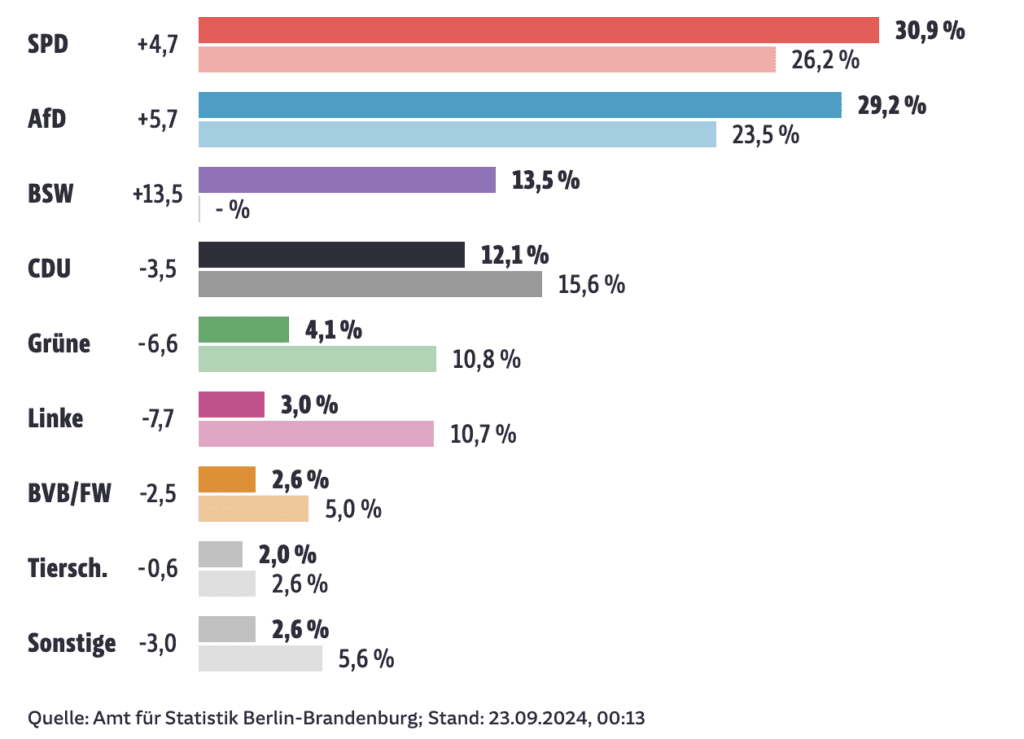
Top candidate of Germany’s Alternative for Germany party for the regional elections in Brandenburg, Hans-Christoph Berndt (center) together with the leader of the AfD party in Thuringia and top candidate in the Thuringia regional elections, Bjoern Hoecke, and AfD co-leaders Tino Chrupalla and Alice Weidel address supporters after the publication of the exit polls of the Brandenburg state elections in Potsdam, eastern Germany, on September 22, 2024.
Photo by John MACDOUGALL / AFP
Germany’s ruling Social Democrats (SPD) managed to narrowly win the regional elections in the eastern state of Brandenburg on Sunday, September 22nd, but the result once again highlights the decline of the mainstream parties, and the rise of right-wing and left-wing populists who are growing in popularity all across the country due to the government’s incompetent handling of the migration and cost-of-living crisis.
According to the latest count the Social Democrats, who have governed Brandenburg since the end of communist rule in East Germany in 1990, received 30.9% of the votes, a 4.5-point increase compared to their result five years ago.
The right-wing anti-globalist AfD (Alternative für Deutschland) are runners-up with 29.2%, rising from 23.5% in 2019. This is another electoral success for the party which only three weeks ago won its first ever election, the state election in Thuringia, and came a close second in another eastern state, Saxony. Co-leader of the party Alice Weidel was “extremely satisfied” with the result, saying “we are the strongest force in the East.”

In Brandenburg, the newly formed left-wing nationalist Bündnis Sahra Wagenknecht (BSW) got 13.5%—a third third-place in a row following a strong showing in both Thuringia and Saxony. The party has been able to capitalise on the collapse of the far-left Die Linke party which it split from last year. The deputy chairman of BSW, Amid Rabieh called the result a success, adding that “there is a great need for a political force that will once again focus on the needs and wishes of the people.”
Die Linke, which used to be a popular party in the eastern regions of Germany, has lost the trust of its voters with its pro-migration and radical green agenda, and is currently on course to drop out of the parliament with its result of 3%.
The centre-right CDU, which has been in a regional coalition with the SPD, dipped to 12.1% to finish fourth—their worst result ever in the state.
The third coalition partner, the Greens are likely to drop out of the state parliament with an abysmal 4.2%. The party—which is a member of the federal government, together with the SPD and the liberal FDP—is being pulverised all across the nation for pushing through radical green policies, tax hikes, and a woke agenda that German citizens have had enough of, especially in the East.
The results are a clear signal that voters want a change, and with federal elections set to take place next year, the left-liberal government will be wise to listen to their concerns. The huge turnout, which rose to a staggering 72.9% from 61% in 2019, only reinforces the argument that there is a desire for a drastic U-turn in government policy.
Another warning signal for the coalition parties in Berlin is the share of votes the AfD and BSW received from younger voters: 32% of 16 to 24 year olds voted for the right-wing party, and 13% for the left-wing nationalists. The Social Democrats managed to get only 18%, while CDU garnered only 9%.
Germany, Brandenburg regional parliament election:
— Europe Elects (@EuropeElects) September 22, 2024
Results for 16-24 year olds (Infratest dimap exit poll)
AfD-ESN: 32% (+14)
SPD-S&D: 18% (+6)
BSW-NI: 13% (new)
CDU-EPP: 9%
LINKE-LEFT: 7% (-4)
GRÜNE-G/EFA: 7% (-20)
BVB/FW~RE: 2% (-2)
FDP-RE: 2% (-4)
+/- vs. 2019 exit poll… pic.twitter.com/7MVe2NNGGw
Blue-collar workers also turned out in large numbers for the AfD: 46% of the group voted for the party. In comparison: SPD got 24%, BSW 12%, CDU 7%.
The results also mean that only four parties will be represented in the state parliament, and the mainstream forces face the same dilemma as in Thuringia and Saxony: what to do with the AfD and the BSW?

The right-wing AfD, which has been stigmatised for its tough stance on immigration, is being blocked from the possibility of forming a government in Thuringia and being part of a coalition elsewhere due to the so-called “firewall,” a cordon sanitaire imposed by other parties. In Thuringia, the CDU, for whom the AfD would be a natural ally, is looking to cooperate with the far-left instead.
According to Süddeutsche Zeitung, SPD and CDU will probably have 44 seats in the 88-seat Brandenburg parliament, not enough for a majority, so the two parties will need the Bündnis Sahra Wagenknecht—either in a minority government or as a coalition partner.
